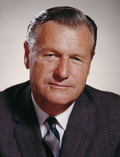Liberal
Members of the party wanted to run an independent campaign and a canvass of party units showed they wanted an independent candidate.
The Liberal Party of New York opposed Rockefeller. Chair Donald S. Harrington viewed him as "too conservative" and Rockefeller fought with Mayor John Lindsay and U.S. Senator Jacob Javits, who the Liberals supported.
O'Connor courted the Liberals, with him appointing Eldon R. Clingan to his staff and promising to Alex Rose that the Liberals would be equals in his campaign. However, O'Connor voted to end cross-endorsements in the state legislature and was close to bosses Charles A. Buckley and Irwin Steingut, who the Liberals opposed. Roosevelt claimed that O'Connor was secretly promised the gubernatorial nomination in exchange for withdrawing from the 1965 New York City mayoral election. President Lyndon B. Johnson and Vice President Hubert Humphrey pressured the party to support O'Connor. Adolf A. Berle, the former chair of the party, supported O'Connor, but Rose criticized Berle as "not even a member of our organization". On August 9, the Liberal Policy Committee voted unanimously to not support him.
Roosevelt lobbied the party's leadership for their nomination for months. David Dubinsky "broke out the 20-year-old scotch" during a meeting according Roosevelt's friends. Dubinsky argued for supporting Roosevelt using polls showing him receiving at least one-fourth of the vote. Louis Stulberg and other leaders of the International Ladies Garment Workers Union opposed Roosevelt due to him not staying with the party after the 1949 election.
Leo Koch nominated James Farmer at the party's convention. Roosevelt won the party's nomination. Murray Kempton stated that the convention was under the thumb of "comrade secretary" Ben Davidson, who chaired the convention. Harrington was selected as the lieutenant gubernatorial nominee.







